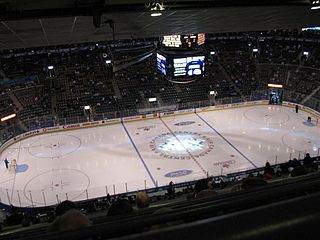
A movie theater, cinema, or cinema hall, also known as a movie house, picture house, picture theater or simply theater, is a business that contains auditoria for viewing films for public entertainment. Most are commercial operations catering to the general public, who attend by purchasing tickets.

An auditorium is a room built to enable an audience to hear and watch performances. For movie theatres, the number of auditoria is expressed as the number of screens. Auditoria can be found in entertainment venues, community halls, and theaters, and may be used for rehearsal, presentation, performing arts productions, or as a learning space.

Ohio Stadium is an American football stadium in Columbus, Ohio, on the campus of Ohio State University. It primarily serves as the home venue of the Ohio State Buckeyes football team and is also the site for the university's Spring Commencement ceremonies each May. Common nicknames for the stadium include "The Horseshoe", "The Shoe", and "The House That Harley Built".

The Olympiastadion, also known in English as the Berlin Olympic Stadium or simply the Olympic Stadium, is a sports stadium at Olympiapark Berlin in Berlin, Germany. It was originally designed by Werner March for the 1936 Summer Olympics. During the Olympics, the record attendance was thought to be over 100,000.

An emergency exit in a building or other structure is a special exit used during emergencies such as fires. The combined use of regular and emergency exits allows for faster evacuation, and emergency exits provide alternative means of evacuation if regular exits are inaccessible.

Brann Stadion is a football stadium in Bergen, Norway. It was constructed in 1919, and has been the home of the football club Brann ever since. The stadium lies 3 km (1.9 mi) south of the city centre, at the foot of Mount Ulriken.

Doak S. Campbell Stadium, popularly known as "Doak", is a football stadium on the campus of Florida State University in Tallahassee, Florida, United States. It is the home field of the Florida State Seminoles football team of the Atlantic Coast Conference (ACC).

Hong Kong Stadium is the main sports venue of Hong Kong. Redeveloped from the original Government Stadium, it reopened as Hong Kong Stadium in March 1994. It has a maximum seating capacity of 40,000, including 18,260 at the main level, 3,173 at executive level, 18,510 upper-level seats and 57 seats for wheelchair users.
An event is described as standing-room only when it is so well-attended that all of the chairs in the venue are occupied, leaving only flat spaces of pavement or flooring for other attendees to stand, at least those spaces not restricted by occupancy by fire codes for ingress/egress of crowds. Some venues issue standing-room-only tickets for a reduced cost since it can become uncomfortable to stand through the course of an event. However, some fans prefer standing-room-only tickets, as the crowds that gather can be more active than people who are sitting down for much of the event.

LaVell Edwards Stadium is an outdoor athletic stadium in the western United States, on the campus of Brigham Young University (BYU) in Provo, Utah. Primarily used for college football, it is the home field of the BYU Cougars, a member of the Big 12 Conference in the Football Bowl Subdivision. Opened as "Cougar Stadium" in 1964, its seating capacity is 62,073. Following the 2024 departure of Oklahoma and Texas for the Southeastern Conference, it is the largest permanent stadium in the Big 12.

Stadium seating or theater seating is a characteristic seating arrangement that is most commonly associated with performing-arts venues, and derives its name from stadiums, which typically use this arrangement.

Davis Wade Stadium, officially known as Davis Wade Stadium at Scott Field is the home venue for the Mississippi State Bulldogs football team. Originally constructed in 1914 as New Athletic Field, it is the second-oldest stadium in the Football Bowl Subdivision behind Georgia Tech's Bobby Dodd Stadium, and the fourth oldest in all of college football behind Penn's Franklin Field, Harvard Stadium, and Bobby Dodd Stadium. As of 2022, it has a seating capacity of 60,311 people.

The luxury box and club seating constitute the most expensive class of seating in arenas and stadiums, and generate much higher revenues than regular seating. Club ticketholders often receive exclusive access to an indoor part of the venue through private club entrances, to areas containing special restaurants, bars, merchandise stands, and lounge areas of the venue that are not otherwise available to regular ticketholders.

St. Jakob-Park is a Swiss sports stadium in Basel. It is the largest football venue in Switzerland and home to FC Basel. "Joggeli", as the venue is nicknamed by the locals, was originally built with a capacity of 33,433 seats. The capacity was increased to 42,500 for Euro 2008, which was hosted by Austria and Switzerland. After the tournament, a number of seats were removed, thus creating more space between them. The capacity was therefore reduced to 38,512 for Swiss Super League matches or 37,500 seats for international matches The maximum capacity for concerts is 40,000.

Alexander Stadium is an athletics stadium in Perry Barr, Birmingham, United Kingdom. It is the largest athletics stadium in the United Kingdom. The stadium has four stands with a total seated capacity of 18,000. The stadium site has four buildings which include the Gymnastics and Martial Arts Centre (GMAC), High Performance Centre, East Stand and newly built West Stand. Original construction began in 1975, and the stadium opened in 1976. It is owned and operated by Birmingham City Council.

A music venue is any location used for a concert or musical performance. Music venues range in size and location, from a small coffeehouse for folk music shows, an outdoor bandshell or bandstand or a concert hall to an indoor sports stadium. Typically, different types of venues host different genres of music. Opera houses, bandshells, and concert halls host classical music performances, whereas public houses ("pubs"), nightclubs, and discothèques offer music in contemporary genres, such as rock, dance, country, and pop.
Within the context of building construction and building codes, occupancy is the use of a building for the shelter or support of persons, animals or property. A closely related meaning is the number of units in such a building that are rented, leased, or otherwise in use. Lack of occupancy, in this sense, is known as vacancy.

Provost Umphrey Stadium is a 16,000-seat multi-purpose stadium located on the campus of Lamar University in Beaumont, Texas. The stadium, home to the Lamar Cardinals football team, is located next to the Montagne Center. While primarily used for football, Provost Umphrey Stadium is also a concert venue with seating up to 20,000 for concerts. The stadium was completely renovated in 2009 and is designed to allow for a future expansion to 28,000.

Clemens Stadium is a football stadium located in Collegeville, Minnesota. The stadium serves as the host stadium to Saint John's University football, track and field teams and other intramural activities. Saint John's Preparatory School's football and track and field teams also use Clemens Stadium as their home facility.

Daily's Place is an amphitheater in Downtown Jacksonville, Florida. The venue is connected to the south end of EverBank Stadium and shares space with a "flex field" indoor practice facility for the Jacksonville Jaguars. It opened in May 2017 and seats 5,500 spectators. Since 2019, the amphitheater has become nationally known as the home venue for the U.S. professional wrestling promotion All Elite Wrestling (AEW).




















